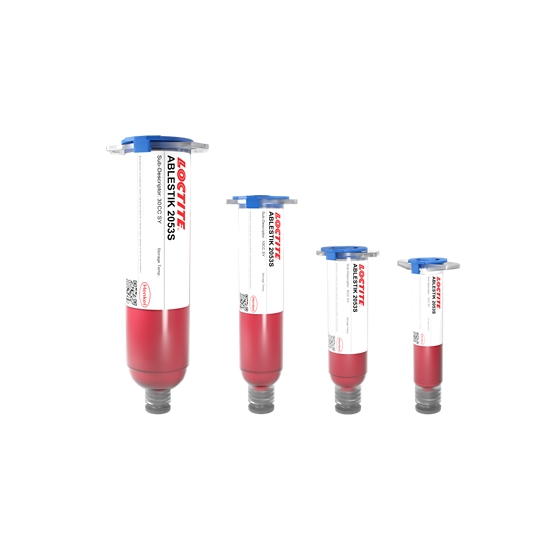LOCTITE ABLESTIK 2053S
- Low stress
- Non Conductive
- Use in Array packaging
Product Description
LOCTITE ABLESTIK 2053S is a polymer filled, hybrid non conductive die attach adhesive with low warpage, high adhesion, low stress and low moisture uptake, designed for use in array packaging. It exhibits great optical performance, complimented by high transmittance, high Optical density and HRI and good adhesion to various interfaces such as EMC, engineering plastic, glass and metals. It is a low modulus, chip bonding, die attach paste for larger die size that works, among others, for chip bonding on FR4 substrates. It is considered a low modulus epoxy alternative to QMI536NB with less tendency to bleed than Bismaleimide containing, QMI materials. The modulus is ~3 times lower so this can be critical for wire bonding small die sizes.
LOCTITE ABLESTIK 2053S offers relatively high thermal conductivity with stable optical performance, good temporary bonding and minimal shift and tilt post reliability. It has been successfully used for the ASIC (Application Specific Integrated Circuit) attach of automotive optical sensors, as a receiver Die attach for 3d sensing modules.
Cure Schedule
- 30 minute @ 175°C + 15 minutes @ 175°C
Technical Specifications
| General Properties | |||||||||||
| Work life @25°C Work life @25°C Work life is the amount of time we have to work with a material until it is no longer able to be easily worked and applied on a substrate. It is based on the change in viscosity and it can rely on the application requirements. | 24 hours | ||||||||||
| |||||||||||
| |||||||||||
| Thermal Properties | |||||||||||
| Glass Transition Temperature (Tg) Glass Transition Temperature (Tg) The glass transition temperature for organic adhesives is a temperature region where the polymers change from glassy and brittle to soft and rubbery. Increasing the temperature further continues the softening process as the viscosity drops too. Temperatures between the glass transition temperature and below the decomposition point of the adhesive are the best region for bonding. The glass-transition temperature Tg of a material characterizes the range of temperatures over which this glass transition occurs. | -21 °C | ||||||||||
| Weight Loss @ 300°C | 2.3 % | ||||||||||
| |||||||||||
| Chemical Properties | |||||||||||
| Moisture absorption | 1 % | ||||||||||
| |||||||||||
| Mechanical Properties | |||||||||||
| |||||||||||
| |||||||||||
| Physical Properties | |||||||||||
| Thixotropic index Thixotropic index Thixotropic Index is a ratio of a material s viscosity at two different speeds in Ambient temperature, generally different by a factor of ten. A thixotropic material s viscosity will decrease as agitation or pressure is increased. It indicates the capability of a material to hold its shape. Mayonnaise is a great example of this. It holds its shape very well, but when a shear stress is applied, the material easily spreads. It helps in choosing a material in accordance to the application, dispense method and viscosity of a material. | 2.5 | ||||||||||
| Viscosity Viscosity Viscosity is a measurement of a fluid’s resistance to flow. Viscosity is commonly measured in centiPoise (cP). One cP is defined as the viscosity of water and all other viscosities are derived from this base. MPa is another common unit with a 1:1 conversion to cP. A product like honey would have a much higher viscosity -around 10,000 cPs- compared to water. As a result, honey would flow much slower out of a tipped glass than water would. The viscosity of a material can be decreased with an increase in temperature in order to better suit an application | 13,000 mPa.s | ||||||||||





